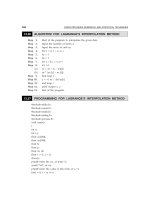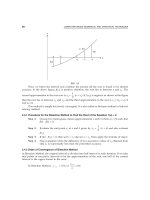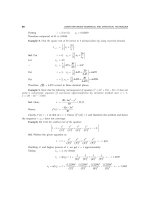A textbook of Computer Based Numerical and Statiscal Techniques part 22 pps
Bạn đang xem bản rút gọn của tài liệu. Xem và tải ngay bản đầy đủ của tài liệu tại đây (99.21 KB, 10 trang )
196
COMPUTER BASED NUMERICAL AND STATISTICAL TECHNIQUES
Example 5. If f(x) is a polynomial of degree four find the value of f(5.8) using Gauss’s backward
formula from the following data:
f(4) = 270, f(5) = 648, ∆f(5) = 682, ∆
3
f(4) = 132.
Sol. Given
(5) 682f∆=
⇒ f (6) – f (5) = 682
⇒ f (6) = 682 + 648
⇒ f (6) = 1330
Also, ∆
3
f (4) = 132
⇒ (E – 1)
3
f (4) = 132
⇒ f (7) – 3f (6) + 3f (5) – f (4) = 132
⇒ f (7) = 3 × 1330 – 3 × 648 + 270 + 132
f (7) = 2448
Now form difference table as:
xfxfxfxfx∆∆ ∆
23
() () () ()
4270
378
5 648 304
682 132
6 1330 436
1118
72448
Take a = 6, h = 1 a + hu = 5.8
∴
0.2u =−
From Gauss backward formula
()
23
1) ( 1)
(1)
(0.2) (0) (1) (1) (2)
2! 3!
uuu
uu
ffuf f f
+−
+
−= +∆−+ ∆−+ ∆−
( 0.2)(0.8) ( 0.2)(0.8)( 1.2)
1330 ( 0.2) 682 436 132
26
−−−
=+−×+ ×+ ×
= 1330 – 136.4 – 34.88 + 4.224
= 1162.944
Hence f (5.8) = 1162.944.
INTERPOLATION WITH EQUAL INTERVAL
197
Example 6. Using Gauss backward interpolation formula, find the population for the year 1936.
Given that
Year
Population in thousands
1901 1911 1921 1931 1941 1951
( )121520273952
Sol. Here h = 10. Take origin at 1941 to evaluate population in 1936
1936 1941 5
0.5
10 10
xa
u
h
−−−
⇒= = ==−
Difference table for given data is as:
ufufufufufufu∆∆ ∆ ∆ ∆
−
−
−
−
−−
−
2345
() () () () () ()
412
3
315 2
50
220 2 3
73 10
127 5 7
12 4
039 1
13
152
Gauss backward formula is
23
(1) (1)(1)
() (0) (1) (1) (2)
2! 3!
uu uuu
fu f uf f f
++−
=+∆−+ ∆−+ ∆−
(2)(1)(1)
4!
uuuu++ −
+
∆
4
f (–2)
5
( 2)( 1) ( 1)( 2)
(3)
5!
uuuuu
f
++ −−
+∆−+
= 39 +
( 0.5)(0.5) ( 0.5)(0.5)( 1.5)
(0.5) 12 1 (4)
26
−−−
−×+ ×+ ×−
= 39 – 6.0 – 0.125 – 0.25
= 32.625 thousands
Hence, the population in 1936 is 32625 thousand.
198
COMPUTER BASED NUMERICAL AND STATISTICAL TECHNIQUES
PROBLEM SET 4.4
1. Given that
12500
= 111.803399,
12510
= 111.848111,
12520
= 111.892806,
12530
= 111.937483. Using Gauss’s backward formula show that
12516
= 111.8749301
2. Find the value of cos 51°42
1
by Gauss’s backward formula from the following data:
50 51 52 53 54
cos 0.6428 0.6293 0.6157 0.6018 0.5878
x
x
°°°°°
[Ans. 0.61981013]
3. The population of a town in the years are as follows:
()
1931 1941 1951 1961 1971
15 20 27 39 52
Year
Population in thousands
Find the population of the town in 1946 by applying Gauss’s backward formula.
[Ans. 22898]
4. Interpolate by means of Gauss’s backward formula, the population of a town KOSIKALAN
for the year 1974, given that:
()
1939 1949 1959 1969 1979 1989
12 15 20 27 39 52
Year
Population in thousands
[Ans. 32.345 thousands appros]
5. Use Gauss interpolation formula to find y
41
from the following data:
y
30
= 3678.2, y
35
= 2995.1, y
40
= 2400.1, y
45
= 1876.2, y
50
= 1416.3
[Ans. y
41
= 2290.1]
6. Use Gauss’s backward formula to find the value of y when x = 3.75, given the following
table:
2.5 3.0 3.5 4.0 4.5 5.0
24.145 22.043 20.225 18.644 17.262 16.047
x
x
y
[Ans. 19.704]
INTERPOLATION WITH EQUAL INTERVAL
199
Stirling’s Formula
Example 1. Evaluate sin (0.197) from the table given:
0.15 0.17 0.19 0.21 0.23
0.14944 0.16918 0.18886 0.20846 0.22798
x
sin x
Sol. The difference table is given by
23 45
2 0.15 0.15 0.14944
0.01974
1 0.17 0.17 0.16918 0.00006
0.01968 0.00002
0 0.19 0.19 0.18886 0.00008 0.00002
0.0196 0
1 0.21 0.21 0.20846 0.00008
0.01952
2 0.23 0.23 0.22798
xxsinx ∆∆ ∆ ∆ ∆
−
−−
−
−
−
∴
u =
xa
h
−
=
0.197 0.19
0.02
−
= 0.35
From Stirling formula, we have
f(u)= f(0) +
() ( )
01
2
uf f
∆+∆−
+
2
2!
u
()
2
1
f
∆−
+
()()
11
3!
uuu
+−
() ()
33
12
2
ff
∆−+∆−
+
()()
2
11
3!
uuu
+−
()
4
2
f
∆−
= 0.18886 + 0.35
()
2
0.35
0.0196 0.01968
22
+
+
×
(–0.00008) +
()
()
()
0.35 1 0.35 0.35 1
6
+−
×
0.00002
2
−
+ (0.35)
2
()
2
0.35 1
0.00002
24
−
×
= 0.18886 + 0.0068741 – 0.0000049 + 0.0000005 – 0.00000009
= 0.19573 (Approx.)
Example 2. Find the value of e
x
= at x = 0.644 using by Stirling’s formula. The following data
given below:
x
x
ye
=
0.61 0.62 0.63 0.64 0.65 0.66 0.67
1.840431 1.858928 1.877610 1.896481 1.915541 1.934792 1.954237
200
COMPUTER BASED NUMERICAL AND STATISTICAL TECHNIQUES
Sol. For the given data difference table is as:
x
xe
∆∆ ∆ ∆ ∆ ∆
−
−
−−
−
−
23456
3 0.61 1.840431
0.018497
2 0.62 1.858928 0.000185
0.018682 0.000004
1 0.63 1.877610 0.000189 0.000004
0.018871 0 0.000006
0 0.64 1.896481 0.000189 0.000002 0.000007
0.01906 0.000002 0.000001
1 0.65 1.915541 0.0
0091 0.000001
0.019251 0.000003
2 0.66 1.934792 0.000194
0.019445
3 0.67 1.954237
Here h = 0.01
∴ u =
0.644 0.64
0.4
0.01
xa
h
−−
==
By stirling formula, we get,
33
3
3
[ (0) (1) (1) (2)
(1)(1)
() (0) (1)
22! 3! 2
uf f f f
uuu
u
fu f f
∆+∆− ∆−+∆−
+−
=+ +∆−+
+
2
45
( 1) ( 1) ( 2)( 1) ( 1)( 2)
( 2) ( 2)
3! 5!
uuu u uuu u
ff
+− ++−−
∆−+ ∆−+
2
(0.4) (1.4)(0.4)( 0.6)
0.01906 0.018871 0.000004
1.896481 0.4 0.000189
22 62
−
+
=+ +×+
22
(0.4) (0.4) 1
24
−
+
(1.4)(2.4)(0.4)( 0.6)( 1.6) 0.000006 0.000001
0.000002
120 2
−− −
×+
2
(0.4 2)(1.4)(0.4)( 0.6)( 0.4 2)
( 0.000007)
720
+−−−
+×−
= 1.896481 + 0.0075862 + 0.00001512–0.000000112 – 0.0000000112 + 0.000000026 – 0.0000002
= 1.904081. (Approx.)
INTERPOLATION WITH EQUAL INTERVAL
201
Example 3. Employ Stirling’s formula to evaluate y
12.2
from the data given below
(y
x
= 1+ log
10
sin x).
5
10 11 12 13 14
10 23967 28060 31788 35209 38368
x
x
y
°
Sol. For the given data difference table is as:
5234
10
10 23967
4093
11 28060 365
3728 58
12 31788 307 13
3421 45
13 35209 262
3159
14 38368
x
xy
°∆∆∆∆
−
−−
−
∴ u = 12.2 – 12 = 0.2
From Stirling formula
[]
{}
()
{}
2
2
2
2
(0.2) 0.2 1
0.2 (0.2) 1
0.2 (0.2) 1
( ) 31788 3421 3728 ( 307) (45 58) ( 13)
22624!
fu
−
−
=+ ++ −+ ++ −
= 31788 – 714.9 – 6.14 – 1.648 + 0.0208
y
12.2
= 32495
10
5
y
12.2
= 32495
∴ y
12.5
= 0.32495. Ans.
202
COMPUTER BASED NUMERICAL AND STATISTICAL TECHNIQUES
Example 4. Apply Stirling’s formula to find a polynomial of degree three which takes the following
values of x and y:
x
y −
2 46810
213820
Sol. Let u =
6
2
x −
. Now, we construct the following difference table:
uuuuu
xuy y y y y
∆∆∆∆
−−
−−
234
222
3
411 1
24
603 3 0
54
818 7
12
10220
Stirling’s formula is
33
2
2
[ (0) (1)] (1) (2)
(1)(1)
() (0) (1)
22! 3! 2
uf f f f
uuu
u
fu f f
∆+∆− ∆−+∆−
+−
=+ +∆−+
+
2
4
(1)(1)
(2)
3!
uuu
f
+−
∆−
22
25 ( 1)44
33 0
22 6 2
u
uuu
yu
+−+
=+ + ×+ +
23
73 2
3()
22 3
uu uu=+ + + −
32
2372
3
3223
uuuu=+++−
32
2317
3
32 6
uu u=+ + +
32
32
2317 2636176
33
32 6 32 22 62
xx x
uu u
−− −
=+++= + + +
= 0.0833x
3
– 1.125x
2
+ 8.9166x – 19.
INTERPOLATION WITH EQUAL INTERVAL
203
Example 5. Apply Stirling’s formula to find the value of f(1.22) from the following table which gives
the value of
2
x
x
2
0
1
f(x) e
2
π
=
∫
dx at intervals of x = 0.5 from x = 0 to 2.
()
0 0.5 1.0 1.5 2.0
0 0.191 0.341 0.433 0.477
x
fx
Sol. Let the origin be at 1 and h = 0.5
∴ x = a + hu, u =
1.22 1.00
0.44
0.5
xa
h
−−
==
Applying Stirling’s formula
[]
33
2
2
(0) ( 1)
(1) (2)
(1)(1)
() (0) (1)
22! 3! 2
uf f
ff
uuu
u
fu f f
∆+∆−
∆−+∆−
+−
=+ +∆−+
+
2
4
(1)(1)
(2)
3!
uuu
f
+−
∆−
∴ f(0.44) = f(0) + (0.44)
2
2
1 (0.44)
[ (0) (1)] (1)
22
ff f∆+∆−+ ∆−
{} {}
222
33 4
(0.44) (0.44) 1 (0.44) (0.44) 1
1
( 1) ( 2) ( 2)
62 24
ff f
−−
+∆−+∆−+∆−
= f(0) + (0.22) [∆f(0) + ∆f(–1)] + 0.0968 ∆
2
f(–1)
– 0.029568 [∆
3
f(–1) + ∆
3
f(–2)] – 0.06505∆
4
f(–2) (1)
The difference table is as follows:
u x fx fx fx fx fx∆∆∆∆
−
−−
−
−
−
33 323334
10 ( ) 10 ( ) 10 ( ) 10 ( ) 10 ( )
20 0
191
10.5 191 41
150 17
01 341 58 27
92 10
1 1.5 433 48
44
2 2 477
204
COMPUTER BASED NUMERICAL AND STATISTICAL TECHNIQUES
f(0) and the differences are being multiplied by 10
3
∴ 10
3
f(0.44)
≈
341 + 0.22 × (150 + 92) + 0.0968 × (–58)
– 0.029568 × (–17 + 10) – 0.006505 × 27
≈
341 + 0.22 × 242 – 0.0968 × 58 + 0.029568 × 7 – 0.006505 × 27
≈
341 + 53.24 – 5.6144 + 0.206276 – 0.175635
≈
388.66
f(0.44) = 0.389 at x = 1.22. Ans.
Example 6. Use Stirling’s formula to find y
28
given.
y
20
= 49225, y
25
= 48316, y
30
= 47236,
y
35
= 45926, y
40
= 44306
Sol. Let the origin be at 30 and h = 5
a + hu = 28
⇒ 30 + 5u = 28 ⇒ u = –0.4
The difference table is as follows:
234
2 20 49225
909
1 25 48316 171
1080 59
0 30 47236 230 21
1310 80
1 35 45926 310
1620
2 40 44306
ux y y y y y∆∆∆∆
−
−
−−
−−
−−
−−
−
−
By Stirling’s formula,
2
(0.4)
1080 1310
( .4) 47236 ( .4) ( 230)
22!
f
−
−−
−= +− + −
(.6)( .4)( 1.4)
3!
−−
+
()
{}
2
2
.4 ( 4.4) 1
59 80
(21)
24!
−−−
−−
+−
Hence, y
28
= 47691.8256.
INTERPOLATION WITH EQUAL INTERVAL
205
PROBLEM SET 4.5
1. Use Stirling’s formula to find y
32
from the following table:
x
y
20 25 30 35 40 35
14.035 13.674 13.257 12.734 12.089 11.309
[Ans. 13.062]
2. Use the following table to evaluate tan 16° by Stirling’s formula:
0 5 10 15 20 25 30
0 0.0875 0.1763 0.2679 0.364 0.4663 0.5774tan
θ°°° ° °°° °
θ°
[Ans. 0.2866980499]
3. Use Stirling’s formula to find the value of f(1.22) from the following data:
xfx()
1.0 0.84147
1.1 0.89121
1.2 0.93204
1.3 0.96356
1.4 0.98545
1.5 0.99749
1.6 0.99957
1.7 0.99385
1.8 0.97385
[Ans. 0.9391002]
4. Find f(0.41) using Stirling’s formula if,
x
fx
0.30 0.35 0.40 0.45 0.50
( ) 0.1179 0.1368 0.1554 0.1736 0.1915
[Ans. 0.15907168]
5. Use Stirling’s formula to find y
35
, data being:
y
20
= 512, y
30
= 439, y
40
= 346, and y
50
= 243,
[Ans. 394.6875]
6. From the following table find the value of f(0.5437) by Stirling’s formula:
0.51 0.52 0.53 0.54 0.55 0.56 0.57
( ) 0.529244 0.537895 0.546464 0.554939 0.663323 0.571616 0.579816
x
fx
[Ans. 0.558052]









